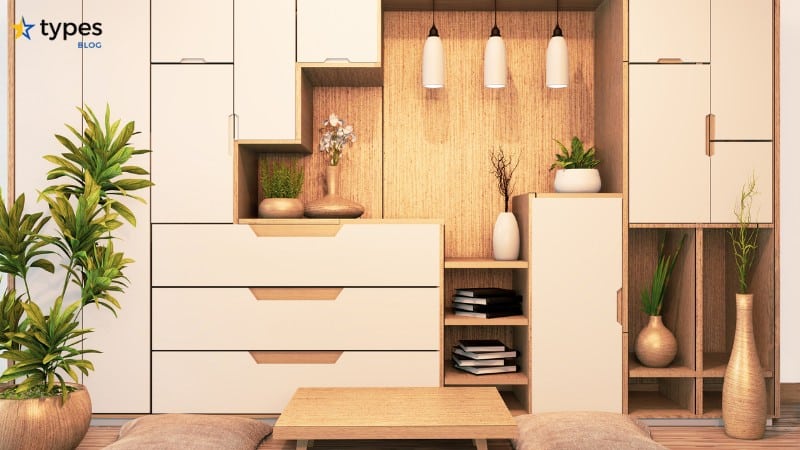Introduction
Importance of drawers in everyday life
Drawers play an essential role in our daily lives as they provide storage solutions to keep our belongings organized and easily accessible. From kitchen utensils to office supplies, having well-constructed drawers ensures that our items are kept safe and secure. Furthermore, the quality and features of drawers determine how long a piece of furniture will last, making it crucial to consider these factors when choosing furniture for our homes.
Drawer Types and Construction
There are various types of drawers available, each designed to serve different purposes. The construction of the drawer box and how it moves within a piece of furniture play a crucial role in determining its strength, durability, and longevity. Let’s explore some of the common drawer types and their construction:
1. Tray Drawer
Tray drawers are commonly found in kitchens and bathrooms as they are ideal for organizing food items or bathroom essentials. They feature a flat bottom and raised sides, keeping the contents contained and easily accessible.
2. Box Drawer
Similar to tray drawers, box drawers have a flat bottom and raised sides. However, they are not specifically designed for organizing food. Instead, box drawers are perfect for storing small items like office supplies, hobby items, or miscellaneous belongings.
3. Stackable Drawer
A stackable drawer is a versatile piece of furniture that can be used in various settings. It features slots on the top and sides, which allow for easy stacking and customization. Stackable drawers offer flexibility in storage solutions, making them an excellent choice for organizing different types of items.
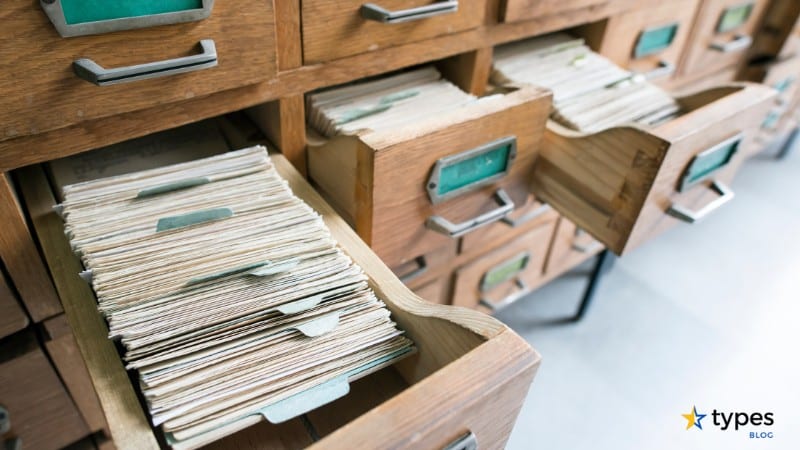
Drawer Features Guide
Apart from the type of drawer, there are specific features that add to their functionality and durability. When choosing furniture with drawers, consider the following features:
1. Drawer Slides
Drawer slides are mechanisms that allow the drawer to open and close smoothly. Look for high-quality drawer slides that are sturdy and have a smooth gliding motion. Soft-close drawer slides are an additional feature that prevents noisy slamming and ensures the drawer closes gently.
2. Dovetail Joints
Dovetail joints are interlocking joints often seen in high-quality drawer construction. These joints provide additional strength and stability to the drawer box, making them more durable and resistant to warping and damage.
3. Full Extension
Full extension drawers allow the entire drawer to be pulled out, providing complete access to the contents. This feature makes it easier to reach items at the back of the drawer and maximizes the available storage space.
4. Bottom Reinforcement
A sturdy bottom reinforcement, such as a plywood or hardwood panel, adds strength to the drawer and prevents sagging or bowing over time. This feature ensures that the drawer can support heavier items without compromising its integrity.
5. Safety Stops
Safety stops are mechanisms that prevent the drawer from accidentally being pulled out too far, reducing the risk of it falling out or tipping over. This feature is particularly important for drawers in households with children, ensuring their safety during use.
6. Quality Materials
Choose furniture with drawers made from high-quality materials, such as solid wood or plywood, for superior durability. Avoid furniture with drawers constructed from flimsy materials that are prone to damage and wear out quickly.
In conclusion, understanding drawer types, construction, and features is vital when choosing furniture for your home. By considering these factors, you can ensure that your drawers will be strong, durable, and functional, providing long-lasting storage solutions for your belongings. So, next time you go shopping for furniture, keep this guide in mind to make informed decisions and invest in pieces that will withstand the test of time.
Basic Drawers
Definition and characteristics of basic drawers
Basic drawers are a staple in kitchens and bathrooms due to their functionality in organizing items. These drawers typically come with a simple design, featuring a rectangular shape and a pull-out mechanism. They are commonly used for storing food items in the kitchen or toiletries in the bathroom. Basic drawers are designed to provide easy access to the items they hold, making it convenient for users to find what they need quickly.
Some key characteristics of basic drawers include:
- Rectangular shape: Basic drawers are usually rectangular in shape, which allows for efficient use of space in cabinets or furniture pieces.
- Pull-out mechanism: These drawers are equipped with a pull-out mechanism that allows users to easily open and close the drawer. The mechanism may consist of tracks or gliders that ensure smooth movement.
- Storage capacity: Basic drawers come in various sizes, providing different storage capacities to accommodate different items.
- Easy organization: With the help of dividers or inserts, basic drawers allow users to organize their items effectively. This makes it easier to locate specific items and keep everything neat and tidy.
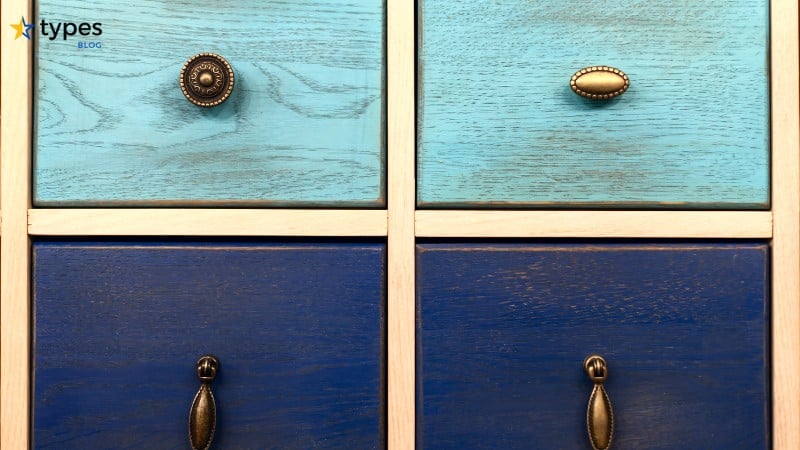
Common materials used for basic drawers
To ensure durability and longevity, basic drawers are typically constructed using sturdy materials. Some common materials used for building these drawers include:
- Solid wood: Solid wood is a popular choice for constructing drawers due to its strength and durability. It can withstand the weight of items placed inside the drawer and is resistant to wear and tear.
- Plywood: Plywood is made by gluing together multiple layers of thin wood veneers, creating a strong and stable material. It is often used for the sides and back of drawers, providing structural support.
- Medium-density fiberboard (MDF): MDF is a composite wood product made by breaking down hardwood or softwood residuals into fibers, combined with resin and wax binder, and formed into panels under high temperature and pressure. It is a cost-effective alternative to solid wood and offers good stability and strength.
- Particleboard: Particleboard is made from wood particles, such as wood chips or shavings, combined with resin and pressed into panels. It is an affordable option for drawer construction but may not be as durable as solid wood or plywood.
When selecting a basic drawer, it is important to consider both the construction and materials used. High-quality materials and proper construction techniques contribute to the longevity and durability of the drawer, ensuring it can withstand the demands of daily use.
Specialized Drawers
Different types of specialized drawers (e.g. file drawers, cutlery drawers)
Specialized drawers are designed to meet specific storage needs for different areas of the home. They are tailored to accommodate specific items and offer unique functionalities. Some common types of specialized drawers include:
- File drawers: File drawers are commonly found in office furniture, providing a designated space to organize and store important documents and files. These drawers are often equipped with a file hanging system to keep files neatly organized and easily accessible.
- Cutlery drawers: Cutlery drawers are a popular addition to kitchen cabinets or drawers. They feature dividers or compartments specifically designed to hold silverware, knives, and other culinary utensils. These drawers help to keep cutlery organized and prevent items from shifting during movement.
- Jewelry drawers: Jewelry drawers are designed to protect and display jewelry pieces. They often feature velvet-lined compartments and special storage inserts to keep jewelry organized and easily visible.
- Appliance drawers: Appliance drawers are commonly found in modern kitchen designs. These drawers are specifically designed to accommodate small appliances, such as microwaves, toasters, or coffee makers, providing a clutter-free countertop space.
- Spices drawers: Spices drawers are a convenient addition to kitchen cabinets or pantry areas. These drawers feature adjustable dividers or spice racks to store and organize a variety of spices, making it easy to locate and access commonly used seasonings.
Unique features and functionalities of specialized drawers
Specialized drawers often come with unique features and functionalities to enhance their performance. These features are designed to make organizing, accessing, and storing specific items more convenient. Some common features of specialized drawers include:
- Customizable inserts: Many specialized drawers offer customizable inserts or dividers, allowing users to configure the space according to their specific needs. This allows for efficient organization and prevents items from shifting during movement.
- Soft-close mechanism: Specialized drawers often come with a soft-close mechanism that ensures a gentle and quiet closing action. This feature helps to prevent slamming and extends the lifespan of the drawer.
- Hidden compartments: Some specialized drawers are designed with hidden compartments or secret storage areas, providing additional space to store valuables or items that require extra security.
- Integrated lighting: Certain specialized drawers, especially those used for jewelry or display purposes, may come with integrated lighting to enhance visibility and showcase the items stored inside.
- Locking mechanisms: For drawers that store valuable items or sensitive documents, locking mechanisms add an extra layer of security, ensuring that the contents are protected from unauthorized access.
Investing in specialized drawers can greatly improve the functionality and organization of your living space. These drawers are often constructed with high-quality materials and employ precise joint construction for durability and longevity. Consider the specific storage needs of each area in your home and choose specialized drawers that best meet those requirements, making your life easier and more organized.
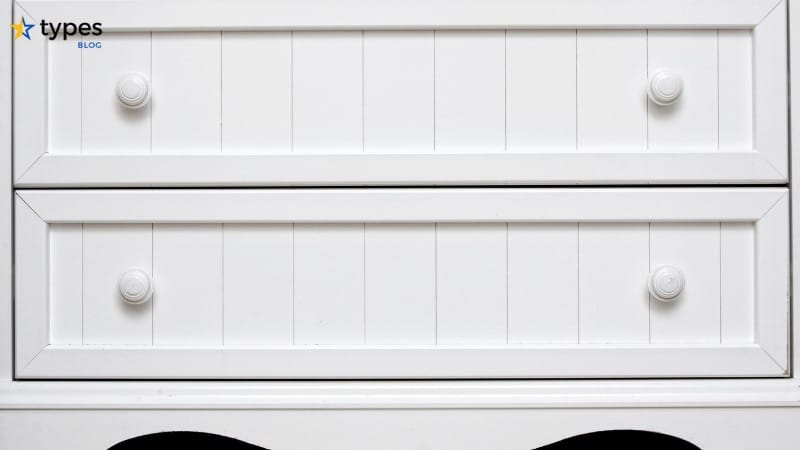
Drawer Construction
Importance of sturdy construction
Having a drawer with sturdy construction is crucial for ensuring its longevity and durability. A well-built drawer can withstand the weight of items placed inside and endure the daily wear and tear of opening and closing. Without proper construction, drawers may become weak, leading to sagging or even falling apart. By investing in drawers with solid construction, you can have peace of mind that your storage pieces will last for years to come.
Different construction techniques and materials used
When it comes to drawer construction, there are various techniques and materials used to create a strong and functional piece. Some common construction methods include:
- Dovetail joints: Dovetail joints are a traditional technique used to connect drawer sides to the front and back panels. These joints are known for their strength and durability, as they interlock with each other and provide stability to the drawer structure. Dovetail joints are often seen in high-quality, handcrafted furniture pieces.
- Butt joints: Butt joints are a simple and straightforward method where the sides of the drawer are joined directly to the front and back panels. This construction technique is commonly used in lower-priced furniture pieces.
- Corner blocks: Corner blocks are additional supports placed in the corners of the drawer to reinforce its structure. These blocks help prevent the drawer from becoming loose or wobbly over time.
In terms of materials, drawers are typically constructed using:
- Solid wood: Solid wood is a popular choice for drawer construction due to its strength and durability. It can withstand heavy items and is resistant to warping or splitting. However, solid wood drawers can be more expensive compared to other materials.
- Plywood: Plywood is made by layering thin sheets of wood veneer together, creating a strong and stable material. It is often used for the sides and back of drawers to provide structural support. Plywood is a more cost-effective option compared to solid wood.
- Medium-density fiberboard (MDF): MDF is a composite wood product made from wood fibers combined with resin and wax binder. It offers good stability and strength, making it a suitable material for drawer construction. MDF is an affordable alternative to solid wood.
- Particleboard: Particleboard is made from wood particles combined with resin and pressed into panels. It is an economical choice for drawer construction but may not be as durable as solid wood or plywood.
By carefully considering the construction techniques and materials used in a drawer, you can choose a piece that will withstand the test of time and meet your storage needs. Whether you opt for the traditional strength of dovetail joints or the affordability of particleboard, a well-constructed drawer will provide the functionality and durability you desire.
Drawer Joinery
Types of joinery used in drawer construction
When it comes to the joinery used in drawer construction, there are several types that can be employed. Each type has its own advantages and considerations to keep in mind. The most common types of joinery used in drawer construction include:
- Dovetail joints: Dovetail joints are a classic and traditional method of joinery. They are known for their strength and durability. Dovetail joints feature interlocking dovetail-shaped projections that provide excellent resistance to pulling forces. This type of joinery is often seen in high-quality, handcrafted furniture.
- Butt joints: Butt joints are a simple and straightforward method where the ends of the drawer sides are joined directly to the front and back panels. This type of joinery is commonly used in lower-priced furniture pieces. While it may not offer the same level of strength as dovetail joints, it can still provide sufficient stability when reinforced with other materials.
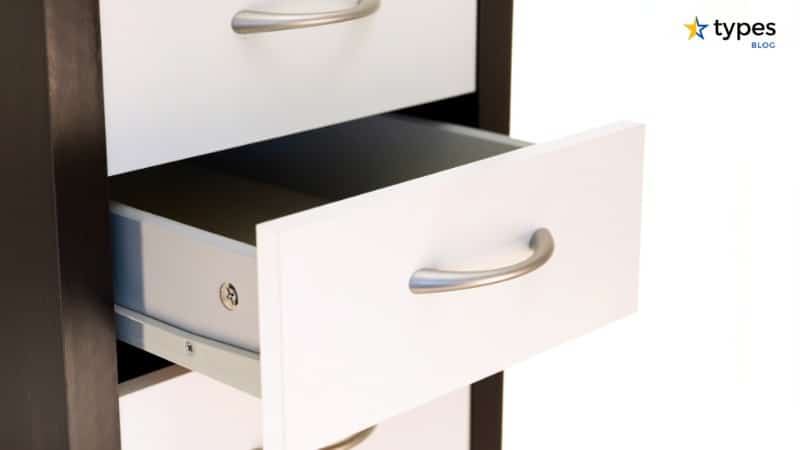
Pros and cons of each type of joinery
Dovetail joints
Pros:
- High level of strength and durability.
- Provides a visually appealing, traditional aesthetic.
- Interlocking design prevents the drawer from coming apart.
Cons:
- More time-consuming and labor-intensive to create.
- Requires skilled craftsmanship.
- Can be more expensive compared to other joinery methods.
Butt joints
Pros:
- Simple and cost-effective construction method.
- Suitable for lower-priced furniture pieces or projects with budget constraints.
- Can still provide sufficient stability when reinforced with corner blocks or other materials.
Cons:
- Not as strong as dovetail joints.
- May require additional reinforcement to ensure long-term durability.
- Less visually appealing compared to dovetail joints.
When considering the joinery used in drawer construction, it is important to weigh the pros and cons of each method based on your specific needs and budget. If you prioritize strength and durability, dovetail joints may be the preferred option. However, if affordability is a key factor, butt joints with proper reinforcement can still provide satisfactory results.
In conclusion, the joinery used in drawer construction plays a significant role in the overall strength and durability of the drawer. Dovetail joints are known for their strength and traditional appeal, while butt joints offer a simple and cost-effective alternative. By understanding the different types of joinery and their pros and cons, you can make an informed decision when selecting storage pieces for your lifestyle. Whether you opt for the elegance of dovetail joints or the practicality of butt joints, a well-constructed drawer will provide reliable functionality and longevity.
Drawer Slides
Different types of drawer slides
Drawer slides are an essential component of drawer construction, as they facilitate smooth movement and support the weight of the drawer. There are several types of drawer slides available, each offering unique features and advantages. Some of the most common types include:
- Wood-on-wood slides: These slides consist of wooden pieces that slide directly on a wooden frame within the case. They are a traditional choice and can offer a smooth and quiet operation. However, wood-on-wood slides may be more susceptible to warping based on changes in temperature and humidity.
- Metal slides: Metal slides, typically made of steel, are a popular choice for their durability and stability. They can support heavier loads compared to wood-on-wood slides and are less prone to warping. Metal slides can be further categorized into:
- Side-mounted slides: These slides are attached to the sides of the drawer and the cabinet. They allow for full or three-quarters extension, providing easy access to the entire drawer.
- Center-mounted slides: These slides are installed underneath the drawer, with a single rail running down the center. They offer a smooth and stable glide but may limit the width of the drawer opening.
- Undermount slides: These slides are concealed underneath the drawer, providing a sleek and seamless appearance. They offer full extension and smooth operation, but may require additional installation steps.
Advantages and disadvantages of each type
Each type of drawer slide has its own advantages and disadvantages, which should be considered when choosing the appropriate slide for your drawers:
Wood-on-wood slides:
- Advantages: Quiet operation, traditional aesthetic.
- Disadvantages: Susceptible to warping, limited weight capacity.
Side-mounted slides:
- Advantages: Full or three-quarters extension, durable.
- Disadvantages: May be harder to remove the drawer completely.
Center-mounted slides:
- Advantages: Smooth glide, stable operation.
- Disadvantages: Limits drawer width.
Undermount slides:
- Advantages: Sleek appearance, full extension.
- Disadvantages: Additional installation steps.
When selecting the appropriate drawer slide, consider factors such as the weight of the items to be stored, the desired extension capability, and the overall design of the drawer. It is also important to ensure that the chosen slide is compatible with the drawer and cabinet construction.
By understanding the different types of drawer slides and their respective advantages and disadvantages, you can make an informed decision that meets your specific needs and preferences. Whether you opt for the traditional elegance of wood-on-wood slides or the durability of metal slides, choosing the right slide will contribute to the overall functionality and longevity of your drawers.
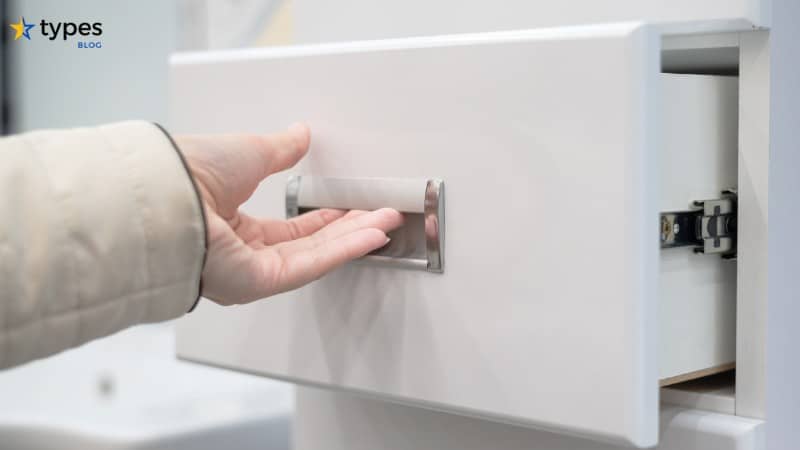
Factors to consider when choosing hardware for drawers
When deciding on the right hardware for your drawers, there are several factors to keep in mind:
- Functionality: Consider how the drawer will be used and what level of access is required. For example, full extension drawer slides allow for easy access to the entire drawer, while three-quarters extension may be sufficient for certain applications.
- Load capacity: Determine the weight that will be placed in the drawer and ensure that the chosen hardware can handle the load. Metal slides generally have a higher weight capacity compared to wood-on-wood slides.
- Design and style: Choose hardware that complements the overall design theme of the space and the furniture. Consider the material, finish, and shape of the hardware to achieve the desired aesthetic.
- Compatibility: Ensure that the chosen hardware is compatible with the specific drawer construction and dimensions. Accurate measurements and understanding of the installation requirements are crucial to ensure a proper fit.
- Budget: Determine a budget for the drawer hardware, considering both the quantity needed and the desired quality. It’s important to strike a balance between cost and durability, ensuring that the chosen hardware will withstand regular use.
By carefully considering these factors, you can select the appropriate hardware that combines functionality and aesthetics for your drawers. Whether it’s choosing stylish drawer pulls, durable slides, or adding decorative elements, the right hardware choices will enhance the overall user experience and contribute to the longevity of the furniture.
Drawer Organization
Tips and ideas for organizing drawers effectively
Keeping drawers organized is essential for efficient storage and easy access to your belongings. Here are some tips and ideas to help you maximize your drawer space and keep everything in order:
- Declutter and categorize: Before organizing your drawers, remove any items that you no longer need or use. Categorize your belongings into groups such as office supplies, kitchen utensils, or clothing accessories.
- Use dividers and organizers: Drawer dividers and organizers are great tools to separate different items and make them easily accessible. They can be used in various sizes and shapes to fit your specific needs. For example, in a kitchen drawer, use dividers to separate utensils, cutting boards, and food containers.
- Utilize vertical space: Make use of stackable drawer organizers to maximize vertical space. These organizers allow you to create multiple layers within a single drawer, providing additional storage options. They are particularly useful in closets for storing folded clothes or accessories.
- Label everything: Labeling is crucial for efficient drawer organization. Use labels or clear plastic pouches to identify the contents of each drawer, making it easier to locate items when needed. This is especially helpful in communal spaces such as offices or shared bathrooms.
- Sort by frequency of use: Consider placing items that you frequently use in easily accessible drawers. For example, in a bathroom, keep everyday essentials like toothbrushes and face moisturizers in a top drawer, while less frequently used items can be stored in lower drawers.
Conclusion
Importance of choosing the right drawers for your needs
Choosing the right drawers for your needs is crucial for effective organization and efficient storage. Whether it’s for your kitchen, office, or bedroom, having the right drawers can make a significant difference in keeping your belongings in order and easily accessible. By taking into consideration factors such as size, functionality, and durability, you can ensure that your drawers meet your specific storage requirements.
Recap of the different types of drawers discussed
Throughout this article, we have discussed various types of drawers and their uses. Let’s recap the types of drawers we have covered:
- Dresser drawers: These are commonly used in bedrooms to store clothing, accessories, and personal items. They come in different sizes and configurations to accommodate various storage needs.
- Kitchen drawers: Kitchen drawers are designed to store utensils, cutlery, cooking tools, and food containers. They can be customized with dividers and organizers to maximize space and keep everything neatly arranged.
- Office drawers: Office drawers are essential for organizing stationery, paperwork, and other office supplies. They often feature multiple compartments and can be locked for added security.
- Bathroom drawers: Bathroom drawers are used to store toiletries, towels, and other bathroom essentials. They can be designed with dividers and organizers to separate different items and make them easily accessible.
- Closet drawers: Closet drawers are perfect for storing folded clothes, accessories, and shoes. They can be customized with stackable organizers to maximize vertical space and keep everything in order.
In conclusion, having well-organized drawers can greatly simplify your daily life and enhance the functionality of your living space. By following the tips and ideas discussed in this article and choosing the right drawer organizers, you can create an efficient and visually appealing storage system. So, take the time to declutter, categorize, and invest in the right drawers to enjoy a more organized and stress-free environment.

